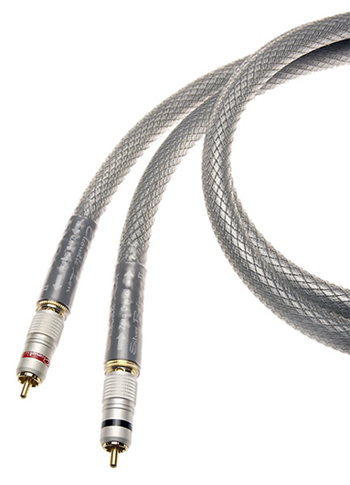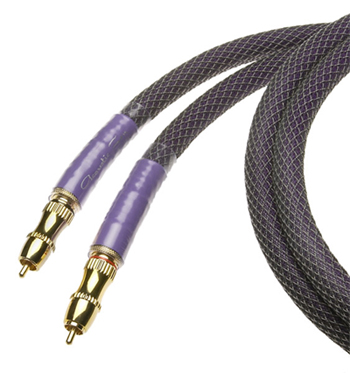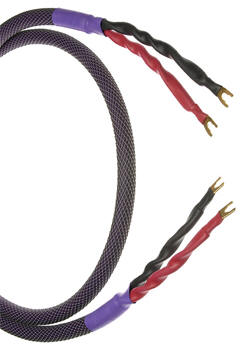You are reading the older HTML site
Positive Feedback ISSUE
17
january/february 2005
acoustic zen
Silver and Matrix II Reference interconnects and the Hologram II speaker cables
as reviewed by John Zurek and John Brazier

|
JOHN ZUREK'S SYSTEM LOUDSPEAKERS ELECTRONICS SOURCES CABLES ACCESSORIES
|
 Some
years ago, I was looking for speaker cables and a coaxial digital cable. Because
I did not have the time and energy for an extensive search, I sought advice from
someone I respect—Jim Merod, the excellent recording engineer and founder of
Blueport Sound, among many other achievements. Jim advised me to check out the
cables from Robert Lee's new company, Acoustic Zen. Jim has probably forgotten
more about audio than I'll ever know, so I took his advice and bought the
cables, and was happy to confirm that Jim was right about them.
Some
years ago, I was looking for speaker cables and a coaxial digital cable. Because
I did not have the time and energy for an extensive search, I sought advice from
someone I respect—Jim Merod, the excellent recording engineer and founder of
Blueport Sound, among many other achievements. Jim advised me to check out the
cables from Robert Lee's new company, Acoustic Zen. Jim has probably forgotten
more about audio than I'll ever know, so I took his advice and bought the
cables, and was happy to confirm that Jim was right about them.
Fast forward to today. I've been using the Acoustic Zen Satori speaker cables for a long time, and they are among the best speaker cables I've heard. Ditto for the MC2 digital cable. As a result, I tried to get some Zen interconnects from Robert Lee for review, but somehow it didn't happen. A few months ago, I was in Los Angeles on business, and spent an evening with Dave and Carol Clark in Long Beach. It turned out that Dave had gotten some AZ cables and didn't have time to review them. Before I knew it, the Zen Silver Reference and Matrix Reference interconnects were tucked into one my bags on the plane back to Colorado.
Pictures do these interconnects no justice. The top-of-the-line Silver Reference ($948/1-meter pair) is wrapped in a lovely silver (of course), with a jacket that looks like it should be reserved for the surface of a space ship. It's thick cable, with locking connectors that are easy to use. The Matrix Reference ($498/1-meter pair) is similar in size and high-tech sheen, but the color is purple and they have a different type of locking connector.
The Silver Reference and Matrix Reference interconnects both sound excellent. Each has the characteristic sound of the metal of which they are constructed (the Matrix References are copper), and would be at the top of my list if I were in the market for interconnects. That said, I simply cannot write the typical review about these cables. Why? When my system became all-Zen, it took on a new personality. It was one of those "ah-haaah" moments in audio. These cables were meant to work together.
Here's how I ended up configuring them: The Satoris, as always, were connected to either my Thiel 3.6s or the very interesting Hyperion HPS-938s (review coming soon). A pair of three-meter Silver Reference interconnects went between my amp and my Cary preamp. A three-meter pair of Matrix Reference interconnects went between my Cary CD player and preamp. A one-meter pair of Silver Reference interconnects went between my Black Cube phono preamp and the Cary preamp. After I started to listen to music, something happened. The music was transformed. Everything I listened to took on a whole new feel. My system was communicating to me in a way it never had before. The Zen wire communicated nuances of emotion, passion, and excitement. The typical audiophile words—highs, mids, transparency, lows, soundstage, dynamics, etc.—could not describe what I heard. Why? I simply didn't care to analyze it. I heard music, and that music communicated with more zest and life than I'd ever heard. Dissecting all the parameters of what I was hearing seemed trivial. I never expected to have this kind of experience by changing a few pairs of interconnects. I have heard electronics sound synergistic, but I was not prepared for this.
Since I was supposed to be reviewing these cables instead of merely enjoying them, I did try moving them around within my system. I found that the magical combination was to use the Matrix References between the source components and preamp, and the Silver References for the preamp-power amp connection. Listening to B.B. King Live at the Cook County Jail, I could feel the mood of the crowd. This was no ordinary concert. These folks were incarcerated. They didn't pay for tickets—they were doing hard time in a terrible place. On "How Blue Can You Get," B.B. does a kind of call and response, first in his own voice, then in a woman's voice: "I bought you a brand new Ford/You said ‘I want a Cadillac'/I let you live in my penthouse/You said it was ‘just a shack'/I bought you a ten dollar dinner/You said it was ‘just a snack'/I gave you seven children, now you wanna give ‘em back." B.B. works this perfectly, and has the audience in the palm of his hand. The inmates love it, and their response becomes part of the performance. It's quite an experience, and the AZ cables put me right there.
I pulled out the old Police standard, Ghost in the Machine, and began with "Sprits in the Material World." I hadn't listened to this album in many years, so I hadn't realized that the spike-haired lads from across the pond were much more than an 80s party band. They were making quite a political statement on this track, one that is relevant today—perhaps even more so today. It got me thinking about their music in a different way. What was I missing when this record came out, more than twenty years ago? And why did it make me so sad listening to it now?
All this melancholic contemplation led me to my ultimate emotion-inspiring musician, Ludwig van Beethoven. I needed some cheering up, so I went straight to the Sixth Symphony, known as the Pastoral. Although Georg Solti is my favorite Beethoven interpreter, I decided to play Herbert von Karajan's 1963 version with the Berlin Philharmonic. I was transported to a green field somewhere in Europe. The sun was shining, the birds were singing, the peaceful brook burbling, or was it just me babbling? Whatever. For me, nature is a spiritual need. I felt refreshed, and once again, the Zen cables succeeded in wringing the emotion from the music.
What more can I say about these wonderful cables? They may not nail every audiophile parameter, but I don't care. They are among the most communicative, musical audio components I've heard. At $498 per meter for the copper Matrix References and $948 for the Silver References, they occupy an interesting price point in the cable market. They are expensive, yet affordable if you compare them to other cables at the same price. They are probably within reach for most audiophiles, even if you have to save up for them. I've listened to some excellent affordable cables lately, ones that I heartily recommended, but sometimes—this time—more expensive is better. I've heard much more expensive wire that can't hold a candle to these. Only you can decide if they are worth the money. I say that they are one of the biggest audio bargains I've ever come across. The motto on the AZ website reads: "At Acoustic Zen, we seek "MUSIC… No compromise!" Music you will get. These cables have my highest recommendation. They are superb. John Zurek
 Acoustic Zen Matrix II Reference
Acoustic Zen Matrix II Reference
|
JOHN BRAZIER'S SYSTEM
LOUDSPEAKERS
ELECTRONICS
SOURCES
CABLES
|
 I
wrote my first audio review for audioasylum.com on the Acoustic Zen WOW
interconnects, which WOW'd me. At the time they deserved landmark status for
their price-to-performance ratio (and no doubt after all this time, still do).
Since then I have kept an eye on Acoustic Zen, as well as having owned most of
their cables, culminating with the Silver Reference II interconnects and
Hologram II speaker cables. The Silver Reference IIs are the company's
top-of-the-line interconnects, but there are two more rungs of the ladder to
aspire to beyond the Holograms (being the Double Barrel and the Absolute). As I
moved up the line from the WOWs to the Silver Reference IIs, each step resulted
in the sound of my system opening up and smoothing out, while the soundstage
expanded to the limits allowed by the associated gear. With the top-of-the-line
Silver Reference IIs in the system, I am now experiencing the ultimate in
openness, refinement, transparency, and delicacy.
I
wrote my first audio review for audioasylum.com on the Acoustic Zen WOW
interconnects, which WOW'd me. At the time they deserved landmark status for
their price-to-performance ratio (and no doubt after all this time, still do).
Since then I have kept an eye on Acoustic Zen, as well as having owned most of
their cables, culminating with the Silver Reference II interconnects and
Hologram II speaker cables. The Silver Reference IIs are the company's
top-of-the-line interconnects, but there are two more rungs of the ladder to
aspire to beyond the Holograms (being the Double Barrel and the Absolute). As I
moved up the line from the WOWs to the Silver Reference IIs, each step resulted
in the sound of my system opening up and smoothing out, while the soundstage
expanded to the limits allowed by the associated gear. With the top-of-the-line
Silver Reference IIs in the system, I am now experiencing the ultimate in
openness, refinement, transparency, and delicacy.
In heavy rotation of late has been Zigaboo Modeliste, I'm On The Right Track; this is an aggressive and excellently recorded funky spin on New Orleans music. Modeliste is the self-proclaimed "King of the Funky Drums". If you enjoy hard hitting drums surrounded by a tight band then check this one out. With lesser cables, some of the edge to this "hard hitting" would be lost. To make this disc the experience that it is, requires the bass to be tightly controlled, while the blackness between the notes has to be very, very back. The combo of the Silver Reference IIs and the Hologram II's are able to deliver the signal without the slightest of bit of mucking. For fun I replaced the Silver References with some old Tera Labs interconnects, which I think were about $100 when I purchased them over 5 years ago, and as you would expect there was an enormous difference between the two. But what really startled me was a complete absence in the "nature of the system as a whole." The King of Funky Drums lost his crown. Gone was the cleanliness and precision of the band playing as a band. The leading edge of the drum hits were not nearly as sharp and tight. Prior to the switch, the drum kit was front and center and the King wouldn't have it any other way. After, the drums were less prominent and seemed to blend in more with the band.
Now, I understand comparing a $100 interconnect with one 10 times its price is really not fair, but I feel I needed a reminder of what was the standard for me sometime ago. More importantly, I was reminded that cables are true "components" in any audio rig, and if you don't think so try playing your's without them.

Much of what I like about the performance of the Silver Reference interconnects applies to the Hologram II speaker cables. The Holograms bring openness and balance to the signals presented to them. They have no signature that I can pin point my finger on. They are remarkably subtle and sweet. I found that the Holograms represented a significant improvement over the Acoustic Zen Satoris. Which I had used for about 2 years and before the Satoris I ran a shot gun run of Kimber Cables 8TC/4TC. They were good cables and like many if Kimber's products bring a remarkable level of performance for their price.
However, by switching to Acoustic Zen products you are bringing your investment to a whole ‘nother level. The differences can be vast for some and subtler for others, but in most cases, what you will get is just a better, more musical sounding set up. The silver-based Reference IIs and Hologram IIs maintain the quality of the signal better than any other cables I have heard.
Acoustic Zen supplies no unique packaging, just good ol' well-insulated wire. Acoustic Zen cables are based on proven technology, but the company simply manages to do things better—much better, to my ears. To some, spending $995 for interconnects is not in the cards. There was a time were I could not justify it either, but the sonic improvements are worth it. With the WOWs at a quarter of that price and the Matrix Reference IIs at half, there are Acoustic Zen cables at price points for everyone. The same holds true for the speaker cables—Five models, five prices. I recommend that you slip in some Acoustic Zens at your price point and begin listening to music. It will sound oh so much better. John Brazier
Hologram Speaker Cables
Retail: $ 1048 pair 8.0 Ft
Silver Reference interconnects
Retail: $948 pair/1.0 meter
Matrx II Reference interconnects
Retail: $ 498 pair/1.0 meter
Acoustic Zen
web address:
www.acousticzen.com
